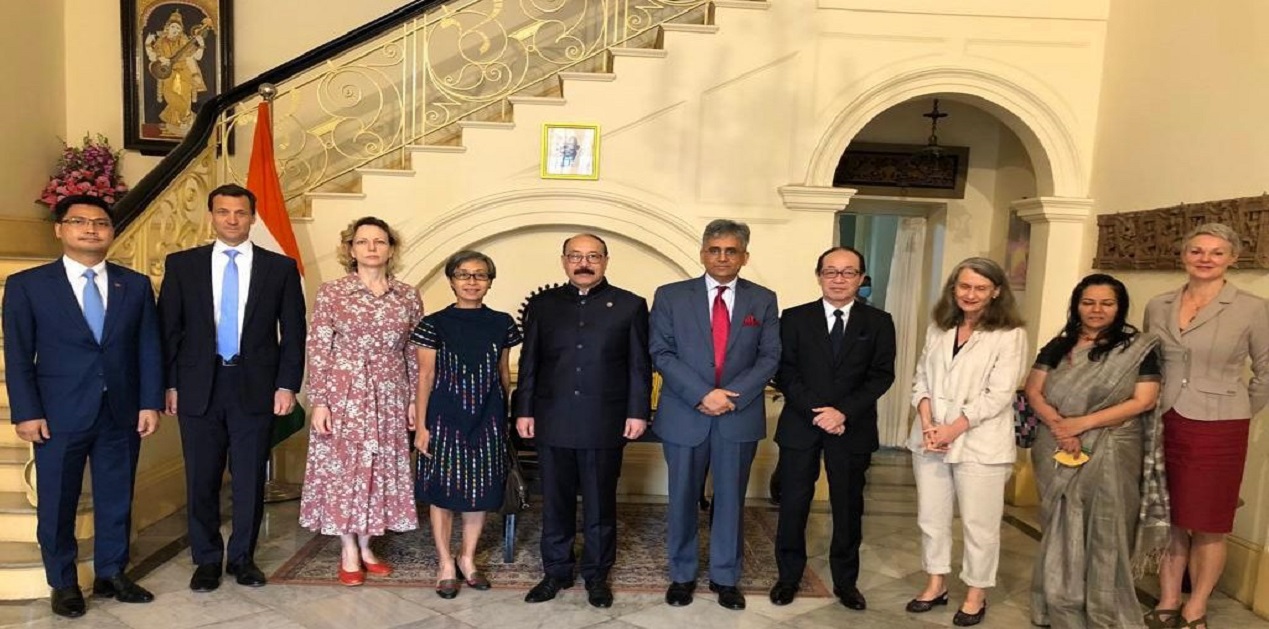Indian Foreign Secretary was in Myanmar (22-23 Dec. 21) meeting with different stakeholders including the the military government and the opposition which continues to oppose the military reinstatement that took place in February 21 post the general election held in 2020. This visit was of importance not only in conveying India’s interest to see Myanmar returning to the path of democratic transition and also lending support to the people to overcome this difficult phase. This latest visit was distinctly different from the one during October 2020 that the FS had undertaken along with Indian Army Chief. Within matter of months the domestic developments had taken a turn upsetting all the past gains towards ushering in multiparty democracy.
India shares a 1,643 km long land border and a 200-km maritime border with Myanmar with four of India’s North-eastern states- Manipur, Nagaland, Arunachal Pradesh and Mizoram being geographically contiguous. This along with a variety of factors, Myanmar is indeed an important neighbour. From lending support to ensuring India’s Northeastern borders remain stable to becoming a partner in India’s transport corridor India is developing with both South Asian and South East Asian neighbours, the growing bilateral partnership has been perceptible. Thus, any domestic change in Myanmar tends to have impact on India and brings forth many outstanding concerns also for the region’s stability.
With Myanmar there are two continued sets of issues that India has had to deal with. Firstly, those surrounding its own border security, which is dotted with ethnic overlaps. And secondly, the political upheavals within Myanmar that contributed to a very unstable domestic situation and pose problems to many joint projects and larger regional plans that have been unveiled.
As is well known, the Indo-Myanmar borderland straddles ethnic overlap and historical reasons have led to separatist feelings and legacy of discontent for long, leaving a shadow on the Indo-Myanmar bilateral trajectory. For long many North-eastern insurgent groups, like Nagas, Mizos and Meitis had bases in Myanmar (erstwhile Burma) as well. Not only these groups have found the Indo-Myanmar border eminently suitable for their free movement across international frontiers, but this region gave way to rampant drug-trafficking from the golden triangle through the North-eastern region. As has been well documented Myanmar was a willing conduit for Chinese involvement in Northeast region too. Invariably, insurgency, drug trafficking and other illegal activities found its way in the porous and hilly terrain of the borders leading to difficult ground situation in Northeast states. It is only recently with the support of Myanmar security cooperation that India has been able to bring many of the insurgents groups to the negotiating table including the mother of all insurgents groups –the National Socialist Council of Nagaland, ensuring a certain amount of stability to this region.
Myanmar’s Brief Political Journey
Myanmar’s own political and economic stability has been jeopardised with longish period of military rule intervention ever since it gained independence from British rule in 1948. It went into military hands post 1962 with General U Ne Win holding power for the next twenty-six years. This regime resulted in extensive restrictions on civil rights, widespread human rights abuses, brutal injustice on its opponents and continuation of a unitary state, which India found difficult to engage with. This was further intensified post the 1988 widespread protests by civilians over deepening corruption and dire economic conditions which were brutally dealt. This resulted into another set of military leaders taking charge and ushering in further changes in its polity with long lasting implications. This phase saw the western nations coming down on Myanmar harshly, imposing specific sanctions. Unrest and instability continued in various quarters leading to another set of reforms.
The junta brought in a new constitution in 2008 bestowing the military with significant powers even under civilian rule leading ‘discipline-flourishing democracy’ that culminated to the elections in 2010 followed by a quasi-civilian government in 2011. However, it was in 2015 Myanmar held its first nationwide, multiparty elections which ushered in a civilian government with Aung San Suu Kyi assuming charge as a newly created position of state counsellor. Since the country’s 2015 elections, which saw the first open vote in 25 years, citizens have high expectations for Myanmar to finally strengthen its democratic institutions and processes. Thus the next round of national elections in 2020 was expected to further loosen the military grip.
The electoral verdict gave National League of Democracy led by Suu Kyi overwhelming majority reducing the military led Union Solidarity and Development Party to merely 33 of 476 votes. The judgement was rather definitive. The humiliation led to a coup in February 2021, unravelling whatever political transition Myanmar had enjoyed in the last few years.
India’s Difficult Manoeuvre
While India has been championing democratic values in the neighbourhood and elsewhere its foreign policy towards Myanmar needed to be rooted in pragmatism to deal with the developing exigencies over the years, indeed post the Feb 21 coup, the rapidly changing security conditions leading to attack on an Army officer and his family in November 13, 2021 and India was left to cope with the huge influx of people across into Northeast states including Mizoram and Manipur.
For India Myanmar has always posed difficult choices. It has been inhibited to espouse its democratic values in the face of non-democratic practices by the military leaders. But in the face of the security concerns over the cross- border insurgency movement India needed the military leaders while also conveying to Suu Kyi the symbol of democratic values its support. Post 1990 India had many more compulsions to reach out to the government in Myanmar.
The definite shift in Indian engagement with Myanmar came about with the initiation of the Look East Policy (LEP) in 1992 that was undertaken to reach out to the tiger economies of the Southeast Asian region. But neither economic outreach nor transformation was possible without addressing the outstanding security problems surrounding the insurgent groups, which necessitated the full support from the security establishment. While implementation of the LEP did increase substantially India’s engagement with Southeast economies and ASEAN engagement in the following decade, post 2014 with the coming of Modi led NDA government in Delhi, the reformulation of this to ‘Act East Policy,’ alongside ‘Neighbourhood First’ led to greater outreach to neighbourhood that involved Myanmar receiving more focussed attention. Exchange of visits, meetings, MOUs led to a flurry of bilateral activities with the neighbour reflected India’s focus on developing border infrastructure and building economic corridors trough a cobweb of transport systems in the region along with partnering Myanmar. Not only that, with India keen to engage with the neighbours through a regional forum and regional organisations of BIMSTEC, Myanmar became a critical neighbour.
At the same time, the engagement also was being reflected in Indo-Myanmar trade ties that had risen from US$ 12 million in early eighties to US$ 100 million in 2000 to reach to $1.7 billion in 2019-20. The hydrocarbon engagement between the two sides has been steadily strengthening and Indian PSU companies have invested over US $ 1 billion in the upstream and midstream sectors in Myanmar.[1] India has extended development assistance to Myanmar on generous terms and its assistance portfolio reached $1.75 billion. The bulk of the assistance is grant-funded and included transport projects- the Kaladan Multimodal Transit Transport Project; the Trilateral Highway Project, which is an East-West corridor connecting our Northeast with Myanmar and Thailand; the Rhi-Tiddim road were some of the significant transport projects undertaken by India. [2] In the past 2001- India has built the160-km Moreh-Tamu-Kalemyo-Kalewa (TKK) Friendship Road in Myanmar (Rs 90-crore).
There was distinct progress in security sector too, with both sides signing an agreement in 2014 for border security and coordinated patrolling. Myanmar has been supportive of India’s operations to address the cross-border security issues with insurgents from Indian northeast crossing border to seek shelters in Myanmar and India was able to initiate rounds of dialogue with the largest long standing Naga insurgent group as mentioned earlier. The military cooperation made it possible for India to tackle the militancy problems effectively.
This apart, India’s bilateral engagement covered people to people contact and led to substantial goodwill from people of Myanmar. Apart from opening border haats (local markets) to facilitate greater cross border linkages with local population on both sides India and Myanmar have initiated several capacity building and strengthening of institutions, in areas including education, information technology and agriculture and others. The initiatives were broadened to include a wider expanse of sectors to ensure that larger numbers of people are benefitted through the bilateral cooperation. The Myanmar-India Centre for English Language Training in Yangon has been very well received and India was keen to replicate such initiatives. China’s growing engagement and need to counter that was also a factor in determining India’s engagement with Myanmar but undoubtedly, with the passage of time, India’s relationship with Myanmar covered multiple stakeholders and India had developed deep stakes in the neighbour and Myanmar’s internal stability was of utmost importance.
However, the latest coup almost instantly changed the ground situation, halting many of the progress that India had recorded in the recent decades. While the international community announced further sanctions and United Nations stated, ‘--It is urgent to mount a unified international and regional response to help to put Myanmar back on the path to democratic reform,’ (August 31, 21) their effect on the military leaders has been limited.[3]
The Indian FS visit was indeed important to convey its unhappiness with the turn of events but also to assure the people that India will continue to lend them support. Thus, Foreign Secretary emphasising, ‘India’s interest in seeing Myanmar’s return to democracy at the earliest; release of detainees and prisoners; resolution of issues through dialogue; and complete cessation of all violence’ clearly conveyed its core interests in democratic values and rule of law’ was a direct censure against the military leaders. [4]
India had in the past showed its ability to work with government in power, irrespective of its nature. But that it wishes to work towards establishment of genuine multi-party democracy in Myanmar was made evidently clear and such engagement with a military government cannot be seen as any endorsement of the policies of the military leaders. On the contrary by handing over a million Covid vaccines, a grant of 10,000 tons of rice and wheat to Myanmar, it has shown it stands with the people of Myanmar. Myanmar government in the past had always conveyed its willingness to work closely with India and they understand the support India can extend, especially in the face of growing economic strain. While there is continued unrest against the military, hopefully, they will understand the futility of such strong-arm tactics which as history has shown can never stand up in face of people’s movement. Return to democracy is inevitable however much Myanmar’s junta wishes to believe otherwise. Will they cut their losses and see reality or continue to drag the process only time will tell.
Endnotes
[1]Press Information Bureau Shri Dharmendra Pradhan meets H.E. Union Minister for Construction, Electricity and Energy of Myanmar Oct 4 2018 at http://pib.nic.in/newsite/PrintRelease.aspx?relid=183948
[2] India-Myanmar Bilateral Relations Jan 2019, at https://mea.gov.in/Portal/ForeignRelation/India_Myanmar_Bilateral_Brief_Website_jan_2019.pdf
[3]United Nation, Urgent’ international response needed in Myanmar: UN chief , UN News 30 Sep 2021 at
https://news.un.org/en/story/2021/09/1101822
[4]MEA, Visit of Foreign Secretary Shri Harsh Vardhan Shringla to Myanmar (December 22-23, 2021), 23 Dec 21 at
https://mea.gov.in/press-releases.htm?dtl/34723/Visit+of+Foreign+Secretary+Shri+Harsh+Vardhan+Shringla+to+Myanmar+December+2223+2021
(The paper is the author’s individual scholastic articulation. The author certifies that the article/paper is original in content, unpublished and it has not been submitted for publication/web upload elsewhere, and that the facts and figures quoted are duly referenced, as needed, and are believed to be correct). (The paper does not necessarily represent the organisational stance... More >>
Image Source: https://cdn.thewire.in/wp-content/uploads/2021/12/23174818/FHSS9fSUcAMpov--1024x600.jpeg











Post new comment